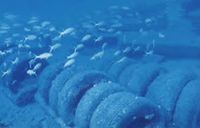UnNews:Plans to build another Mt. Everest postponed
22 February 2007
WASHINGTON, D. C. - Scientists have postponed plans to build a new Mt. Everest after one of their 1972 attempts to engineer nature was decreed an “ecological disaster” by the National Academy of Sciences.
The 1972 project involved the construction of an artificial reef made of abandoned tires that would otherwise take centuries to decompose in the country’s landfills. “We wanted to make room for more important garbage in America’s dumping grounds,” Hiram Hymen told Unnews’ reporter Lotta Lies, “such as disposable diapers, booze bottles, and the corpses of our nation’s serial killers’ victims.”
To secure the tires to one another, they were chained together, and to make them more attractive to sea life, the tires were then enmeshed in nylon.
Goodyear, one of the United States’ largest tire manufacturers, sold the federal government on the idea, insisting that an alleged scientific study that the corporation had funded demonstrated that the artificial barrier would be a paradise on earth, of sorts, for marine life and that their product, once it was no longer marketable, would make “excellent ... reef material.”
“Whoever bought that argument was smoking reefer,” Dr. Otto Octavius, better known as “Dr. Octopus,” or “Doc Oc,” for short, told The Daily Bugle’s editor J. Jonah Jameson. “Most likely, there was some money involved, too, on Goodyear’s part, to help key Congressional representatives of the American people see the supposed wisdom of such an enterprise.” In reality, Doc Oc contended, “the idiots couldn’t have built a better lethal weapon against maritime life.”
Despite the nylon that the otherwise naked tires wear, virtually no sea life of any kind has been attracted to the tires. Over the years, several hundred, perhaps thousand, of the tires have broken loose of their chains and rolled hither and yon across an area of the ocean’s bottom the size of Texas. Many have washed up on the beaches of the world’s most exclusive summer resorts, and others have blocked coral growth and devastated marine life on a nearby coral reef after becoming wedged against it during their wandering journeys.
“Nations from the U. S. to Argentina are pissed off,” Doc Oc said, “and demand that something be done about this fiasco.”
Goodyear has offered to sink several of its blimps to cover up the mess, but environmentalists insist on a cleanup rather than a cover up. The tire manufacturer refuses to finance the reclamation of the area and the disposal of the 2,000,000 tires that were used to construct the artificial reef. “We supplied the tires; that’s enough,” Goodyear spokesman Bernard (“Blimpie”) Bunion said.
At taxpayer expense, the U. S. Navy will used highly-trained dolphins to clean up the mess. “Normally, they’re used for espionage purposes, but theses James Bonds of the Deep, as we call them, can also lend a helping hand - or flipper - to the proposed clean-up operation,” the Navy’s Admiral Akbar said.
Previous efforts to use tires to create artificial reefs have also ended in disaster, with rubber fragments breaking free to litter distant beaches and create international incidents with the United States’ friends and foes south of the border. In one instance, it was discovered that concrete is a cheaper material to use than discarded tires, much to the embarrassment of the state of New Jersey, whose taxpayers financed the project.
The clean-up operation is expected to take a month and cost taxpayers approximately a dollar a tire, or $2,000,000 total. “The next time I see a Goodyear blimp, I’m going to shoot the damned thing down,” Lester Fenton, an outraged environmentalist vowed, earning himself a stint in a federal penitentiary for making a terrorist threat.
Due to the negative publicity that has resulted from turning “much of the Atlantic Ocean into a watery landfill”, Doc Oc said plans to build an artificial Mt. Everest on Wake Island have been put on hold. The scheme called for the use of discarded tin cans to be compressed and collected in concrete cubes that would be chained together and enmeshed in women’s nylon pantyhose and then stacked, one atop another, to a height of over 32,000 feet. The purpose of the project, Doc Oc said, was to see whether such a feat could be accomplished, and the reason for the experiment was the opposite of that supplied by many who climb the actual, authentic Mt. Everest (or die trying). “They say ‘because it’s there,’” Doc Oc said. “Members of the scientific community say, in this case, ‘because it’s not there.’”
The plan to build a Mt. Everest of tin cans has been postponed “indefinitely”, according to its proponents. However, other scientists are considering the construction of an artificial desert in Idaho that would use pulverized glass from wrecked automobiles and other vehicles in lieu of sand and the creation of a man-made tornado made of a cone-shaped, three-mile-long latex “membrane.”
“Those eggheads have too much time on their hands,” Fenton said, speaking between reruns of I Love Lucy episodes he was watching in his prison cell. “They’re going to end up causing global warming or a food shortage or some such catastrophe, but, when they do, they won’t end up in jail like me. They‘ll probably end up with a Nobel Prize.”
Source[edit | edit source]
- Lotta Lies "Where the rubber meets the water: maybe they should hold off on building Uranus, too" Instant News, 49 seconds ago



